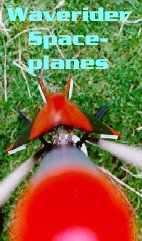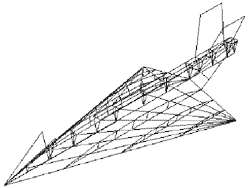
The Mark 8 and Mark 12 Waveriders
The Mark 8 and Mark 12 Waveriders are STAAR Research designs, concentrating on evolving the original Mark 7 Waverider 'Caret' straight-leading edged design into a more viable vehicle. Upper-body fuselage volume and stabilising aerodynamic surfaces have been added to the basic design to allow subsonic performance improvement, despite the severe 73 degrees of sweepback of the leading-edges.

The Mark 8 waverider builds upon the highly succesful work with the 3 surface layout, remotely piloted Mark 7 waverider: Highly swept back canards, a main lifting surface (provided by shaping the upper fuselage), and on the Mark 8 waverider, a `V` tail mounted back on a boat-tailcone instead of a vertical tail and wingtip fins.
A subscale model of the Mark 8 waverider was chosen as a payload experiment for the Anglo/Russian Juno mission in which British cosmonaut, Helen Sharman, flew to the MIR space station. Various test articles were constructed for this purpose by STAAR Research. However, due to a number of funding difficulties at a high level, the scientific payload was largely cancelled. The waverider experiment thus did not get to fly.
The Mark 12 waverider is an improved Mark 8 waverider.





